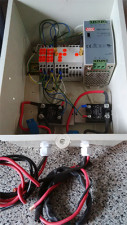
When 32-year-old Litabe Shadrack observed the high levels of electricity theft in his community of Maokeng in Kroonstad, he knew that something had to be done about it.
At the age of 28, while working as a master installer electrician at Motla Consulting Engineers, he discovered criminals who made illegal connections to steal from Eskom were causing electricity outages in many areas.
This is what inspired Shadrack to invent the Saggitarious Serpentarious system, which detects and identifies the exact location of illegal electricity connections and meter tampering in a given area.
He was sponsored by the Technology Innovation Agency's (TIA's) Youth Technology Innovation Fund.
According to Shadrack, the Saggitarious Serpentarious system is used to detect and prevent electricity theft on prepaid meters, credit meters or conventional meters.
Although there are several similar systems used by municipality already, they can be bypassed or tampered with and they don't reveal detailed information about the theft.
"With the existing system, if you bypass the prepaid meter by cutting the wire going through the prepaid meter, it is undetectable and the perpetrators may not get caught," Shadrack explains.
However he says what sets his invention apart is that it uses two separate devices which monitor electricity usage from inside and outside the home.
"The Saggitarious Serpentarious has a device that measures electricity consumption inside the household and another device - a master device that measures electricity that is pumped from the transformer box outside the house to the inside of the house," he says.
The two devices compare electricity consumption and if there is a mismatch, the master device disconnects the house from the grid.
One master device monitors ten houses at the same time. As soon as electricity is disconnected, a report is sent to a control room and Shadrack is then able to detect the exact location of tampering or illegal connection. The device provides detail on the type of tampering that occurred, be it opening the meter, the use of fake Eskom tokens or an illegal connection.
"We have the ability to restore electricity to the house as soon as the culprit has made arrangements to pay fines.
"Our system does not require any retrofitting, meaning that it works on all kinds of electricity meters, including smart meters."
The device is also able to detect if the prepaid meter has been opened for tampering, he adds. In the case of tampering, the system will shut down the resident's electricity connection and wirelessly send the resident's electricity details and error codes to the municipality.
This will also mean that the resident will have to report the fault to the municipality in order to get reconnected to the grid.
The Youth Technology Innovation Fund judges awarded Shadrack a cash prize of R365 610 for prototype development as part of several vouchers offered through the TIA.
"The funds were paid to the Technology Station in Electronics at Tshwane University of Technology in order for us to build a fully functional prototype which was later tested at SABS.
"The TIA paid for my patent protection and I received quarterly stipends for two years from the TIA," Shadrack disclosed.
Pilot run
Shadrack says he is currently busy with a pilot run of the project and TIA will be assisting to fund the production of 55 units. He already has an appointment letter from Moqhaka Municipality for the pilot run of the system which will be installed in various homes.
"In South Africa, electricity theft has gone to a stage where it is deemed economic sabotage. The country is fighting a losing battle and building more power stations will not solve the problem.
"Eskom is operating at a loss due to illegal electricity connections, electricity usage and the sale of fake electricity tokens. Municipalities are also unable to support Eskom financially for the bulk of electricity stolen," he points out.
Shadrack says this is what motivated him to submit a proposal to the Youth Technology Innovation Programme (YTIP), an initiative that identifies and assists young innovators in SA.
"This programme is designed to assist young innovators to access risk funding, mentorship and business support and it seeks to play the connector role in supporting the development of new technologies by the SA youth, which can solve various social and technological challenges," says Madimetja Segobola, acting head of YTIP.
At the moment Shadrack says he is seeking commercial funding of around R10 million to mass produce the units and start installing for the Moqhaka municipality and Eskom.
He says the product went through and passed all SABS tests last year. Initially SABS used to issue certification on partial tests but he was told the regulations had changed.
"This means we have to go back and repeat all the tests that the product passed, however this is just a formality," he points out.
Shadrack has now registered a start-up called Litabe Technologies, to pursue his dream of combating electricity theft while providing employment opportunities within the energy sector.
He says it was his previous job of installing Geyser Control Switches in consumer distribution boards for engineering company Motla Consulting Engineers that gained him the wealth of experience he needed to build the Saggitarious Serpentarious system.
"The idea for installing Geyser Control Switches was to control the demand for electricity consumption during peak times, to prevent load shedding and power outages caused by high consumption of electricity."
Share